当前位置:
X-MOL 学术
›
PLOS Negl. Trop. Dis.
›
论文详情
Our official English website, www.x-mol.net, welcomes your
feedback! (Note: you will need to create a separate account there.)
Risk of dengue in Central Africa: Vector competence studies with Aedes aegypti and Aedes albopictus (Diptera: Culicidae) populations and dengue 2 virus.
PLOS Neglected Tropical Diseases ( IF 3.4 ) Pub Date : 2019-12-30 , DOI: 10.1371/journal.pntd.0007985 Basile Kamgang 1 , Marie Vazeille 2 , Armel N Tedjou 1, 3 , Theodel A Wilson-Bahun 1, 4 , Aurélie P Yougang 1, 3 , Laurence Mousson 2 , Charles S Wondji 1, 5 , Anna-Bella Failloux 2
PLOS Neglected Tropical Diseases ( IF 3.4 ) Pub Date : 2019-12-30 , DOI: 10.1371/journal.pntd.0007985 Basile Kamgang 1 , Marie Vazeille 2 , Armel N Tedjou 1, 3 , Theodel A Wilson-Bahun 1, 4 , Aurélie P Yougang 1, 3 , Laurence Mousson 2 , Charles S Wondji 1, 5 , Anna-Bella Failloux 2
Affiliation

|
INTRODUCTION
Dengue is the most important mosquito-borne diseases worldwide but was considered scarce in West-Central Africa. During the last decade, dengue outbreaks have increasingly been reported in urban foci in this region suggesting major epidemiological changes. However, in Central Africa where both vectors, Aedes aegypti and Aedes albopictus are well established, the role of each species in dengue transmission remains poorly investigated.
METHODOLOGY/PRINCIPAL FINDINGS
Field-collected strains of Ae. aegypti and Ae. albopictus from different ecological settings in Central Africa were experimentally challenged with dengue 2 virus (DENV-2). Mosquitoes were analysed at 14- and 21-days post-infection. Analysis provide evidence that both Ae. aegypti and Ae. albopictus in Central Africa were able to transmit dengue virus with Ae. aegypti exhibiting a higher transmission rate. Unexpectedly, two Ae. aegypti populations from Bénoué and Maroua, in northern Cameroon, were not able to transmit DENV-2.
CONCLUSIONS/SIGNIFICANCE
We conclude that both Ae. aegypti and Ae. albopictus are susceptible to DENV-2 and may intervene as active dengue vectors. These findings highlight the urgent need to plan a vector surveillance program and control methods against dengue vectors in Central Africa in order to prevent future outbreaks.
中文翻译:

中非登革热的风险:埃及伊蚊和白纹伊蚊(双翅目:Cu科)种群和登革热2病毒的媒介能力研究。
简介登革热是全世界最重要的蚊媒疾病,但在中西部非洲却被认为是稀缺的。在过去十年中,该地区城市疫源地的登革热暴发越来越多,表明流行病学发生了重大变化。但是,在非洲中部埃及伊蚊和白纹伊蚊均已建立的媒介中,每种物种在登革热传播中的作用仍未得到很好的研究。方法学/主要发现野外采集的菌株。埃及和埃及。来自中非不同生态环境的白化病在实验中受到登革2型病毒(DENV-2)的攻击。在感染后14天和21天对蚊子进行了分析。分析提供的证据表明,两者都存在。埃及和埃及。中部非洲的白带能够通过Ae传播登革热病毒。埃及y显示出更高的传输速率。没想到,两个Ae。来自喀麦隆北部贝努瓦和马鲁阿的埃及埃及人无法传播DENV-2。结论/意义我们得出结论,两个Ae。埃及和埃及。白化病对DENV-2敏感,可能作为活跃的登革热媒介物介入。这些发现突出表明,迫切需要制定针对中非登革热媒介的媒介监测计划和控制方法,以防止未来爆发。
更新日期:2019-12-31
中文翻译:

中非登革热的风险:埃及伊蚊和白纹伊蚊(双翅目:Cu科)种群和登革热2病毒的媒介能力研究。
简介登革热是全世界最重要的蚊媒疾病,但在中西部非洲却被认为是稀缺的。在过去十年中,该地区城市疫源地的登革热暴发越来越多,表明流行病学发生了重大变化。但是,在非洲中部埃及伊蚊和白纹伊蚊均已建立的媒介中,每种物种在登革热传播中的作用仍未得到很好的研究。方法学/主要发现野外采集的菌株。埃及和埃及。来自中非不同生态环境的白化病在实验中受到登革2型病毒(DENV-2)的攻击。在感染后14天和21天对蚊子进行了分析。分析提供的证据表明,两者都存在。埃及和埃及。中部非洲的白带能够通过Ae传播登革热病毒。埃及y显示出更高的传输速率。没想到,两个Ae。来自喀麦隆北部贝努瓦和马鲁阿的埃及埃及人无法传播DENV-2。结论/意义我们得出结论,两个Ae。埃及和埃及。白化病对DENV-2敏感,可能作为活跃的登革热媒介物介入。这些发现突出表明,迫切需要制定针对中非登革热媒介的媒介监测计划和控制方法,以防止未来爆发。











































 京公网安备 11010802027423号
京公网安备 11010802027423号